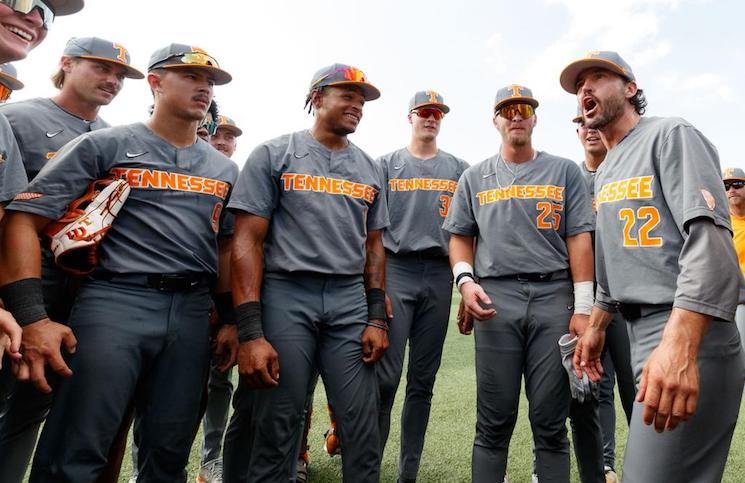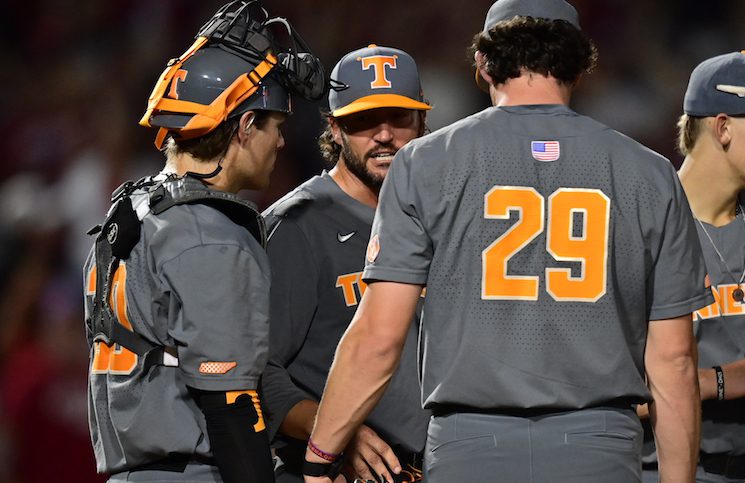
Much has been made about the departing production off of Tennessee’s men’s basketball roster this offseason. Across the board, the Vols are losing a little over two-thirds of their production in just about every major category. Tennessee is losing a two-time SEC Player of the Year, a First Team All-SEC wing, a Second Team All-SEC point guard, and a multi-year starter at center.
But what do the Vols actually return off the 2018-19 roster for this upcoming season?
Tennessee may be losing a lot off of last season’s team, but that doesn’t mean the roster is bare of returning talent. In fact, the Vols should be spearheaded by arguably the best guard combo in the SEC this upcoming season.
Senior guards Lamonte Turner and Jordan Bowden will likely be Tennessee’s main sources of offense in the 2019-20 season, and both appear up to the task. After being the third or fourth or sometimes fifth scoring options the last two years, both Turner and Bowden will probably be the No. 1 and No. 2 scoring options for the team this year.
Though Admiral Schofield led the Vols in three-point shooting and three-pointers made last season, both Turner and Bowden were big parts of UT’s success — or sometimes lack thereof — from distance. With those two and the smaller three-point shooting contributions from Yves Pons and Jalen Johnson, Tennessee actually returns almost half (44.3 percent) of their three-pointers made from last season.
And Turner did most of his damage while not being 100 percent.
Turner was slow to get back into the rotation early in the season after offseason shoulder surgery, and he ended up playing pretty much the whole season banged up. Because of that, Turner’s three-point shooting percentage dropped from 39.5 percent as a redshirt sophomore to 32 percent as a redshirt junior.
But if Turner’s play down the stretch of the season is any indication of what UT will get from him in his final year as a Vol, then the SEC better look out.
After an extended cold streak that started with the Vols’ blowout loss to Kentucky on the road in mid-February and lasted all the way to the close of the regular season, Turner finally found his shooting touch again in tournament play. Turner only took one three in UT’s win against Mississippi State in the SEC Tournament, and he made the decisive three against Kentucky in the closing minutes to propel the Vols to victory.
From there on out, Turner was on fire.

In Tennessee’s final four games of the season, Turner connected on 12 of his 26 threes (46.2 percent) and averaged 16.8 points, 3.5 assists, 3.3 rebounds, and 1.3 steals while shooting 48.9 percent overall in a whopping 38.3 minutes per game. In fact, Turner outplayed second-round draft pick Jordan Bone down the stretch for UT. In that same span, Bone averaged just 12.8 points, 3.0 assists, and 3.8 rebounds while shooting 40.8 percent overall and 38.9 percent from three in 36 minutes a game.
Turner had to have more minor offseason shoulder surgery shortly after the 2018-19 season came to a close, but he’ll have much longer to recover this time than he did last year. Assuming there are no setbacks, Turner should be ready to go as Tennessee’s top scoring threat next season.
Bowden was deadly from distance in his third year with the Vols, nailing 37.8 percent of his 135 three-pointer attempts. The issue with Bowden was consistency, something UT will need more of from him this upcoming season.
The 6-foot-5, 195-pound Knoxville native thrived in his sixth man role once he was transitioned to there early in the season. Bowden started the first five games of the season before being moved to the bench, and he was almost always the first player off the bench to enter games. In that role, Bowden initially looked like a Sixth Man of the Year award winner, averaging 12.8 points, 3.1 rebounds, and 2.3 assists while shooting 49.7 percent overall and 38.6 percent from three in his first 18 games off the bench.
Then, Bowden hit a wall, averaging just 3.8 points in a four-game stretch in late February where he failed to make a single three-pointer in 11 attempts.
After that spell, though, Bowden returned to form and finished the season averaging 11.6 points and 4.2 rebounds a game while shooting 44.7 percent from three over Tennessee’s final nine games of the season.
Assuming both Turner and Bowden stay healthy this season, both will likely leave their names in Tennessee’s record books when it comes to three-pointers made. Turner already has 160 makes from distance, which is just six away from passing C.J. Watson for the 10th-most in a UT career in school history. Bowden has 137 made threes in his career, meaning he’ll likely break into the top 10 by the end of his senior season as well.
But Vol fans know what Turner and Bowden bring to the table. What about the rest of the returning players?
The Vols didn’t run a deep bench once they got deeper into SEC play, and that leaves a lot of question marks about the three other returning players who saw the court last season. John Fulkerson saw the most action, but he averaged just 12 minutes a game in his role as the main big man off the bench. But he usually made those minutes count when he got in the game.
Though his block total (25) isn’t that impressive, the rate at which Fulkerson rejected shots was actually very solid. Fulkerson averaged a blocked shot every 17.3 minutes of game action last season. That was the second-best on the team among qualifying players. Only Kyle Alexander’s average of a block every 13.8 minutes was better. Grant Williams was second on the team in total blocked shots, but he only averaged a block every 21.5 minutes.
Fulkerson was also an efficient rebounder when he was on the floor. In fact, he averaged almost as many offensive rebounds a game (1.1) in his limited action as Admiral Schofield did (1.2) in his much more expanded role. The sophomore had the third-best total rebound percentage on the team with a 12.4 percent mark. Only Kyle Alexander (15.9 percent) and Grant Williams (13.3 percent) had better.
The 6-foot-8, 200-pound forward will see his minutes increase quite a bit as a junior, but he’ll need to work on his passing and jumper to earn a larger role in what will be a young but promising frontcourt.
Aside from those three players, there are a lot more question marks for UT’s returning roster.
Yves Pons and Jalen Johnson suffer from the exact opposite problem. Pons’ defense makes him valuable, but he seemed to lose confidence in his offensive game after a promising start to the season. On the flipside, Johnson’s offense shows a lot of potential, but he was easily Tennessee’s weakest defender when he was on the floor last season.
Pons started the season as a key contributor off the bench, and he was given a starting role to help alleviate the pressure off Bowden. Initially, Pons took to his new starting role, scoring a career-high 10 points and pulling down five rebounds in his first start in UT’s win against Eastern Kentucky. He would average 5.4 points, 3.7 rebounds, and 1.4 assists in 21.7 minutes per game in his first seven games as a starter, shooting 59.3 percent overall and making 36.4 percent of his threes.
But once Tennessee entered SEC play, Pons seemed to lose his moxy on offense.
In his final six starts of the season, Pons went scoreless twice and was relegating himself to either shooting threes or only attempting dunks. Seven of his 11 field goal attempts in those six games were from behind the perimeter, and he only attempted two free throws total in those six games.
After that, Pons was never the same player, and he only played double-digit minutes in three of his final 17 appearances.
As for Johnson, he never really got to show what he could do because of his ineffectiveness on defense. He only appeared in 26 games and averaged just under six minutes a game when he got on the floor. The redshirt sophomore made more than one field goal in only three games total last season.
The only other returning players from last year’s roster didn’t see the court any. Rising redshirt sophomore forward Zach Kent and rising redshirt freshman forward DJ Burns will fill roles in the frontcourt, and both have a lot of potential if they can stay healthy and have improved their conditioning.
Kent has yet to be healthy in his two previous years at UT, but the 6-foot-11, 225-pound forward is believed to be a decent outside shooter who can play a stretch-four role. Burns redshirted last year after reclassifying from the 2019 class into the 2018 class and signing with the Vols. He worked on his conditioning, shedding some weight and adding more muscle. The 6-foot-8, 250-pound forward was the highest-rated player from a recruiting standpoint on Tennessee’s roster last season.
Tennessee welcomes in a ton of new faces to the roster this upcoming season, but the players they do return have a lot of promise. But outside of Lamonte Turner and Jordan Bowden, there’s a lot more mystery than anything else.
Expect to see Tennessee’s returning players get more minutes early in the season. If they prove they aren’t up to task, though, the Vols’ newcomers will likely take away their playing time and slide into those roles.



